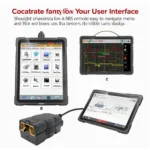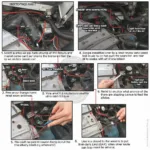OBD2, or On-Board Diagnostics, is a standardized system that allows external electronics to access a vehicle’s computer and retrieve diagnostic information. This essential technology provides valuable insights into your car’s performance and health. This guide will explore everything you need to know about OBD2, from its basic functionality to its advanced applications.
Understanding OBD2 is crucial for any car owner in today’s automotive landscape. It empowers you to identify potential issues, monitor vehicle performance, and make informed decisions about maintenance and repairs. This comprehensive guide will delve into the intricacies of OBD2, demystifying its technical aspects and revealing its practical benefits.
What is OBD2 and How Does it Work?
OBD2 is a standardized diagnostic interface present in most vehicles manufactured after 1996 (in the United States). It enables communication between a vehicle’s electronic control unit (ECU) and an external diagnostic tool, known as an OBD2 scanner. This communication channel allows access to a wealth of data, including diagnostic trouble codes (DTCs), sensor readings, and other operational parameters. OBD2 scanners act as translators, converting the complex data into a user-friendly format. This information can be used to diagnose problems, track performance, and even customize certain vehicle functions.
After the initial check engine light illuminates, the OBD2 system stores a pending code. This code becomes a confirmed trouble code after a second driving cycle with the same problem. OBD2 empowers car owners to troubleshoot issues efficiently and effectively.
Just after this section, I think a visual aid would be helpful.
Decoding OBD2 Trouble Codes (DTCs)
DTCs are standardized codes that indicate specific malfunctions within a vehicle’s systems. These codes are essential for diagnosing problems and directing repair efforts. Understanding the structure of these codes is crucial for efficient troubleshooting. Each code begins with a letter, followed by four numbers. The letter indicates the system affected (e.g., “P” for powertrain, “B” for body, “C” for chassis, “U” for network). The numbers specify the nature of the fault.
For example, the code P0302, as discussed on our BMW OBD2 P0302 page, indicates a misfire in cylinder 2. Being able to interpret these codes can save valuable time and money when addressing car problems. Resources like the OBD2 Codes-P0106 page can offer further insight into specific trouble codes.
Benefits of Using an OBD2 Scanner
Using an OBD2 scanner can offer numerous benefits to car owners:
- Early Problem Detection: Detect issues before they become major problems, potentially saving on costly repairs down the road.
- Enhanced Understanding: Gain a deeper understanding of your car’s performance and overall health.
- Cost Savings: Potentially reduce diagnostic fees at repair shops by identifying the problem yourself.
- Improved Fuel Efficiency: Identify issues that could be impacting fuel economy and take corrective action.
- DIY Repairs: For those mechanically inclined, OBD2 scanners can facilitate DIY repairs by pinpointing the source of the issue.
Beyond diagnostics, OBD2 can even enhance your driving experience. For instance, tools like those discussed on the OHP ELMConfig Forscan OBD2 page allow for customizations and modifications.
Advanced Applications of OBD2
Beyond basic diagnostics, OBD2 technology has evolved to encompass a broader range of applications. These include:
- Real-time Vehicle Monitoring: Monitor various parameters like speed, RPM, and coolant temperature in real time.
- Performance Tuning: Adjust certain engine parameters to enhance performance (for off-road use).
- Fleet Management: Used in commercial fleets to track vehicle location, monitor driver behavior, and optimize fuel consumption.
- Integration with Smartphones and Apps: Connect your smartphone to your OBD2 scanner and access a wealth of data and features through dedicated apps. You can even enhance your in-car entertainment with options like Android Auto Automatic OBD2.
For Nissan owners experiencing specific issues, understanding OBD2 codes is invaluable, as detailed on the Nissan OBD2 code P0325 page.
 Advanced OBD2 Software on a Laptop
Advanced OBD2 Software on a Laptop
Conclusion
OBD2 is a powerful tool that provides valuable insights into the health and performance of your vehicle. By understanding how OBD2 works and how to utilize an OBD2 scanner, you can take control of your car’s maintenance, save money on repairs, and enjoy a more informed and connected driving experience. OBD2 explained simply empowers you to become a more knowledgeable and proactive car owner.
FAQ
-
What does OBD2 stand for? OBD2 stands for On-Board Diagnostics, version 2.
-
Do all cars have OBD2? Most cars and light trucks sold in the United States after 1996 are equipped with OBD2.
-
Where is the OBD2 port located? The OBD2 port is typically located under the dashboard, near the steering wheel.
-
What can an OBD2 scanner tell me? An OBD2 scanner can read diagnostic trouble codes, display sensor readings, and provide other operational data.
-
Do I need a professional to use an OBD2 scanner? No, many OBD2 scanners are user-friendly and designed for everyday car owners.
-
Can I fix my car myself using an OBD2 scanner? While an OBD2 scanner can diagnose problems, repairs may still require professional assistance.
-
How much does an OBD2 scanner cost? The price of an OBD2 scanner varies depending on features and functionality.
Common OBD2 Scenarios
- Check Engine Light Illuminates: This is the most common scenario. Use an OBD2 scanner to retrieve the trouble code and identify the problem.
- Poor Fuel Economy: OBD2 can help pinpoint issues affecting fuel consumption.
- Performance Issues: Diagnose problems like misfires or loss of power using an OBD2 scanner.
- Regular Maintenance: Use OBD2 to monitor vehicle health and anticipate potential problems.
Further Reading and Resources
For additional information, explore other helpful articles on our website related to specific car makes, models, and trouble codes.
For support, please contact us via WhatsApp: +1(641)206-8880, Email: [email protected] or visit our office at 789 Elm Street, San Francisco, CA 94102, USA. We offer 24/7 customer support.

